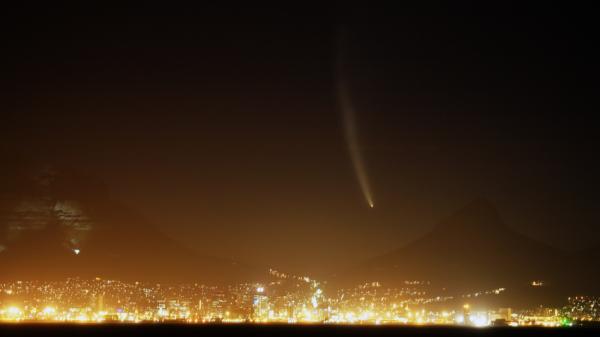2013: Year of comets
2013 is going to be a good year for comet watchers, with at least 3 comets that may be visible to observers on Earth without the aid of sophisticated equipment.

Comet McNaught over Cape Town in 2007.
©iStockphoto.com/Don Bayley
The first of these, C/2012 F6, can be seen from the Southern Hemisphere in the months of February and March. The other two, C/2011 L4 (PANSTARRS) and C/2012 S1 (ISON), can be seen later in the year.
C/2012 F6 (Lemmon Comet)
The C/2012 F6, also know as Lemmon Comet, was discovered in 2012. Named after the observatory it was discovered by, the comet has surprised astronomers by its brightness. Initially thought to reach its peak brightness in March, 2013, the comet is getting brighter than it was previously expected to. Astronomers expect that the comet will be observable to the unaided eye from the Southern Hemisphere and tropical regions all through the months of February and March. However, the best chance of seeing it would be through binoculars.
The comet will reach its perihelion – its closest point to the Sun – around March 23-24, 2013, after which it is expected to be visible in the Northern Hemisphere until May.
C/2011 L4 (PANSTARRS)
The next comet to grace our skies will be C/2011 L4, also known as PANSTARRS. Named after the telescope that was used to discover it in 2011, the comet is slated to be closest to the Earth and the Sun in early March, 2013. It is estimated that the comet will be easily observable in the Northern Hemisphere during the month of March. PANSTARRS is a non-periodic comet, which means that its passage through its perihelion has only been (or will be) observed once in recorded history. PANSTARRS belong to the Oort Cloud, and it is thought that it took millions of years to reach its current position.
C/2012 S1 (ISON)
C/2012 S1 or ISON comet is the next bright comet that is likely to be visible without sophisticated equipment later in 2013. Discovered by the International Scientific Optical Network (ISON), C/2012 S1 will be closest to the Earth in December 2013 and will start becoming visible to observers on Earth in August 2013. Astronomers think that there is a chance that the comet may disintegrate when it comes close to the Sun. If it does not disintegrate, it will become extremely bright and will be visible to the unaided eye until early January 2014.